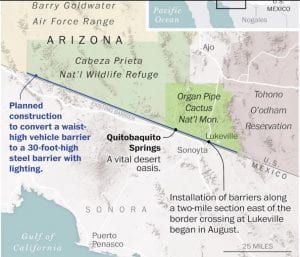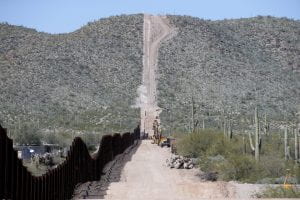
Border wall location: Source NY Times
Many readers are likely aware of the construction of a border wall taking place along the boundary of the Organ Pipe National Monument. While construction and infrastructure expansion are an inevitable part of society and has the potential to impact archaeological sites, this construction project has completely negated all cultural and environmental resources legislation and is currently destroying culturally sacred sites to the local Native American Tribes. Normally, such projects go through a survey process laid out in the National Historic Preservation Act of 1966 to identify and mitigate damage to potentially important archaeological sites. However, the REAL ID Act of 2005 allows the Secretary of Homeland Security to waive all local, state, and federal laws that would impacts construction along the border, negating all the efforts of past government officials to protect not only cultural resources and descendant communities, but also the environment and protected federal lands.
Numerous groups such as SAA

The Border wall going through Monument Hill Arizona. Source: Tuscon.com
and the Sierra Club have condemned the act and the actions following its approval. SAA detailed their grievances in a letter to Acting Secretary of Homeland Security Chad F. Wolf demanding that all construction efforts cease until proper compliance regulations are completed (Link to letter here). The construction has thus far destroyed many archaeological sites, sacred Native American burial grounds, and is currently threatening an oasis site which is not only sacred to the Tohono O’odham people but also of natural importance. The project is using explosives to level Monument Hill, a burial location for Apache warriors. Not only did the REAL ID Act of 2005 threaten irreplaceable resources, but it also threatens the checks and balances foundation of our government, give the Secretary of Homeland Security power over any law.

Explosives being used on Monument Hill likely destroying burials. Source: azcentral.com
It is not only national and international organizations that have condemned these actions, but also news media outlets such as the Washington Post, The New York Times, NPR, and Smithsonian Magazine have also reported on the construction of this 30-foot high wall. The lack of respect toward remains and burial grounds is not only morally abhorrent but completely goes against the principles of the Native American Grave Protection and Repatriation Act, one of the many acts subverted Homeland Security. All the laws in place that have been waives for this wall exist for a very good reason. They are meant to protect human rights, culture, the environment, and endangered species while also allowing for infrastructure expansion. These laws work in harmony with construction projects not against them. Amazing things can happen if those at the top simply understand why these so-called blocks on progress exist, how they work, and their actual impact on construction projects. They do not stop construction or prevent the destruction of all sites. What they do is mitigate damage in creative and efficient ways. This might mean a full-scale excavation of the impacted area, or a rerouting of a road, or it could be simply recording what is found and proceeding with the project as planned. Archaeologists and environmentalists are here to help infrastructure not prevent it.
Follow IUP Anthropology on Facebook, Twitter, and Instagram